

Synthetic Phonics - learning the letter sounds with Jolly Phonics Jolly Learning. In Jolly Phonics the 42 main sounds of English are taught, not just the alphabet.
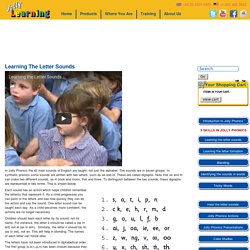
The sounds are in seven groups. In synthetic phonics some sounds are written with two letters, such as ee and or. These are called digraphs. Note that oo and th can make two different sounds, as in book and moon, that and three. To distinguish between the two sounds, these digraphs are represented in two forms. Each sound has an action which helps children remember the letter(s) that represent it. Children should learn each letter by its sound, not its name. The letters have not been introduced in alphabetical order. Sounds that have more than one way of being written are initially taught in one form only.
For more information on Jolly Phonics products visit our Products section. ALPHABET. Para enseñar el abecedario en Inglés a niños, podemos recurrir a muchos recursos, como canciones y rimas, o también a flashcards y pósters, los cuales suelen ir asociados a palabras para aprender, al mismo tiempo, nuevo vocabulario.
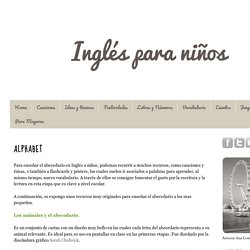
A través de ellos se consigue fomentar el gusto por la escritura y la lectura en esta etapa que es clave a nivel escolar. A continuación, os expongo unos recursos muy originales para enseñar el abecedario a los mas pequeños.Los animales y el abecedario. Es un conjunto de cartas con un diseño muy bello en las cuales cada letra del abecedario representa a su animal relevante. Es ideal para su uso en pantallas en clase en las primeras etapas. Fue diseñado por la diseñadora gráfico Sarah Chidwick. A través de este enlace, puedes descargar todas las letras: DESCARGA ABC ANIMALESTambién referido a los animales contamos con el siguiente, con imágenes reales a modo del flashcards. Nos lo podemos descargar aquí: DESCARGA ABC ANIMALES II.
How do you teach preschool phonics? If your child is still at preschool phonics still plays an important part.
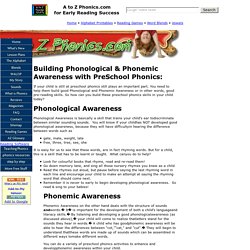
You need to help them build good Phonological and Phonemic Awareness or in other words, good pre-reading skills. So how can you build these preschool phonics skills in your child today? Phonological Awareness is basically a skill that trains your child's ear todiscriminate between similar sounding sounds. You will know if your childhas NOT developed good phonological awareness, because they will have difficultyin hearing the difference between words such as gate, mate, weight, late free, three, tree, see, she It is easy for us to see that these words, are in fact rhyming words.
Look for colourful books that rhyme, read and re-read them! Find an Alphabet Craft. With so many alphabet craft items available today, from Beads Buttons Stencils Stamps Cutters learning the alphabet has never been so much fun!

Here are some ideas how to use crafts in your alphabet lessons at home or school: Buy Alphabet Beads and get your students to make their own Alphabet Necklace - Key Ring - Bracelet. Make an A-Z bead snake - threaded onto a string. Teach them the Alphabet Song and point to each bead as they sing. The Alphabet. ABC letter alphabet sounds. One of the first stepsfor reading success is having a firm knowledge of the abc letteralphabet.
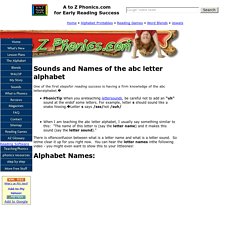
PhonicTip:When you areteaching lettersounds, be careful not to add an "uh" sound at the endof some letters. For example, letter s should sound like a snake hissing.Letter s says /sss/not /suh/ When I am teaching the abc letter alphabet, I usually say something similar to this: "The name of this letter is (say the letter name) and it makes this sound (say the letter sound). " There is oftenconfusion between what is a letter name and what is a letter sound.
So letme clear it up for you right now. You can hear the letter names inthe following video - you might even want to show this to your littleones! Teaching Alphabet Letters. Here are activities and suggestions for teaching alphabet letters.
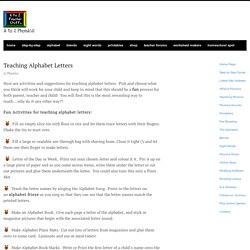
Pick and choose what you think will work for your child and keep in mind that this should be a fun process for both parent, teacher and child! You will find this is the most rewarding way to teach….why do it any other way?! Fun Activities for teaching alphabet letters: Fill an empty slice tin with flour or rice and let them trace letters with their fingers. Shake the tin to start over. Fill a large re-sealable see-through bag with shaving foam. Letter of the Day or Week.